Social Media Customer Service 2022 Industry Report
Juphy
Manage every social media customer inquiry on a single platform with Juphy Never miss a message, improve customer satisfaction, and save time. See it in action.
Free DemoIn this Social Media Customer Service Report, our goal is to inform you of the newest statistics, brand examples, customer data, and 2023 insights so that you can optimize your strategies and resources for more efficient social customer care management.
Every time a customer receives customer support on social media platforms or networks, that’s social customer service in action.
Many customers in today’s world opt to be serviced on social media for two main reasons. Firstly because it’s become an integral part of their lives, and secondly, they’re more likely to get genuine, personalized, and satisfactory help on such platforms.
Social media customer service is gaining fast traction due to the rise in online businesses today. With the increase in online businesses comes the need for quick and proactive customer service practices, or your business stands the risk of losing customers to competitors who do it better.
After COVID-19, the social media customer service industry is progressing more rapidly, making even small businesses adopt strategies accordingly. We started to see new job listings of social media customer service representatives from well-known, big brands. Many industries began to invest in social media customer service by creating new departments and training their current customer service or social media teams for better customer experiences.

You can download this content as a free e-book by filling out the form below.
What Is Social Media Customer Service?
Social media customer service (SMCS) is the practice of using social media platforms and social tools to resolve customer requests or complaints, answer inquiries, resolve purchase problems, provide more information, and even issue refunds. Social platforms where customer and customer service support interactions may take place also include social media posts, direct messages (DMs), and online reviews.
Customers today are looking for businesses that provide rapid yet human, effective solutions to their problems. With social media customer service, you can surpass your customers’ expectations by providing excellent, personalized, round-the-clock services that keep them loyal to your business.
Another prime benefit of offering SMCS to your customers is portraying your brand’s reliability and customer-centricity. Social media customer service makes it easy for brands to relate with customers on a more personal level — a plus in the books of consumers.
Consumers prefer brands and services that they can connect with, and social media customer service allows you to do so easily. Brands that understand how to leverage the power of interaction and personalization in customer service marketing win their customers’ hearts and make them loyal brand ambassadors.

Starbucks understands the importance of acknowledging customer feedback and has even set up a website that tells its customers, “we care about your opinion; tell us more here.”
Brief History of Social Media Customer Service
Before laying out the SMCS industry report for 2021 – 2022, it’s good practice to look back at how far the industry has come over the years and how well it’s stuck to its trajectory for growth. It’s impossible to examine the history of SMCS without taking a quick peek at how it all started — customer service.
The history of customer service dates as far back as 1750 BC. It began in the form of writing on clay tablets in Ancient Mesopotamia. From there, it moved on to the Industrial Revolution era, which laid the key foundation for customer service as we know it today.
Between the 1870s and 1890s, the telephone and switchboard were invented—a game changer for customer support teams. It eliminated the need for sales reps and customers to travel long distances to get or provide help for challenges or file complaints.

From the 1960s to the 1990s, call center customer support and call center outsourcing was the order of the day and became well-established customer service strategies.
In the early 1990s, the world was introduced to the internet. With the internet came the emergence of online marketplaces like Amazon, a giant leap that paved the way for eCommerce. The emerging style of commerce, various new channels of communication, and technological advancement created the need for internet-enabled software for customer service in the 2000s. This is known as CRM technology today.
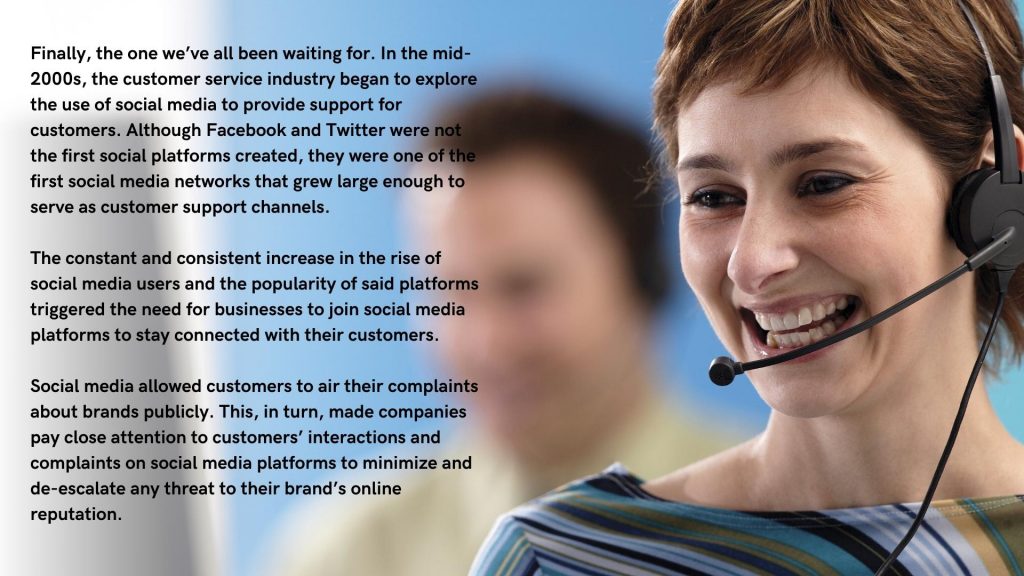

Today, 80% of consumers use social media for brand engagement. The further development of social media messaging features (in the early 2010s), like direct messaging (DM), made it more practical and swift for brands to interact with customers personally and privately.
Looking at the timeline of the customer service industry’s growth, one thing’s for sure — it’s a fast-changing industry. The key drivers of change in this industry remain customers’ preferences and needs, as well as technological advancements. Brands that pay close attention to these drivers and keep up with the industry changes are on the fast track to customer success.
How Did Covid-19 Affect the SMCS Industry?
Like many industries, the social media customer service industry was not spared during the Covid-19 pandemic. The Covid-19 era was a period of contactless communication, not just for family and friends but also between clients and brands.
A brand’s ability to provide exceptional service even in a crisis is one of the factors that immediately contributes to how customers perceive the brand even many years after. During the pandemic, the customer service industry was tasked with juggling customer satisfaction and attending to increasing support tickets while also managing to maintain social distancing and personal security.
In 2018, a survey conducted by Gartner predicted that 25% of the customer service industry would run operations using Chatbots and AI by 2020. When the pandemic struck, the reality of this survey was proved, and the forecasted number of businesses that adopted AI-assisted customer support increased.
To maintain peace in the eye of the storm for already rattled and distraught customers, many businesses looked to already existing technological systems and increased their social media support to provide customers with quick and efficient customer service round-the-clock.

A consistent rise in customer support tickets from March 2020 to August 2021 (Source: HubSpot)
Multiple social media platforms reported a spike in usage once social distancing measures were implemented. Facebook Analytics team recorded a 50% increase in messaging in March 2020, for instance. Social customer support teams, just like families and friends, leveraged messaging and video-calling tools to provide one-on-one assistance for customers.
Chatbots integrated into social messaging platforms like Facebook Messenger were also vital in providing customers with immediate, real-time feedback during the pandemic. The bots focused on handling repetitive, minor queries, freeing up tickets for the social customer service agents so that they could focus on more important, urgent queries.
With most social customer service teams working remotely during the pandemic, teams also invested in social media customer service tools. These tools helped SMCS teams boost collaboration, provide personalized assistance, and keep track of multi-channel social interactions with customers.
The goal for social customer care teams during the pandemic was to continue to maintain and provide quality standards of service for customers.
Chatbots integrated into social messaging platforms like Facebook Messenger were also vital in providing customers with immediate, real-time feedback during the pandemic. The bots focused on handling repetitive, minor queries, freeing up tickets for the social customer service agents so that they could focus on more important, urgent queries.

With most social customer service teams working remotely during the pandemic, teams also invested in social media customer service tools. These tools helped SMCS teams boost collaboration, provide personalized assistance, and keep track of multi-channel social interactions with customers.
The goal for social customer care teams during the pandemic was to continue to maintain and provide quality standards of service for customers.
Despite social distance challenges, poor health quality, extreme burnout, and increased demand for support, social customer service teams leveraged technology and social tools to meet customers’ needs during the Covid-19 pandemic.
Social Media Customer Service Indicators
Consumer Appeal
How well do your customers, fans, and followers on social media like your brand based on their interactions with you on social media?
- Volume of Published Messages: This refers to the sum of inbound messages from customers you have to attempt to reply to on social media platforms within a specific period. Not all inbound messages are tickets that require resolution; some may include feedback or reviews about your products and services.
- Engagement Rate: This is the total number of engagements a post on social media receives divided by the total number of impressions on the post. For example, if your Instagram video gets 500 views and 50 engagements, then the post has a 5% engagement rate.
- Post Comments: Comments are a form of engagement, usually indicated by the written remark or opinion that customers leave on a social post, usually including text, hashtags, @mentions, and emojis.
- Direct Messages: These are special appreciatory messages from fans and followers who admire or support your brand, product, or service. They could be sent to the DM, posted in the comments, or even mentioned your brand on their page.
Brand Responsiveness
How quickly is your SMCS team inclined to attend to and resolve customer issues on social media?
- First Response Time: This indicates the time customers have to wait to get a response from a member of your SMCS team. To calculate your average first response time, add the sum of your first response times in a period and divide by the total number of responses in that period.
- Volume of Replied Direct Messages: This refers to the total number of inbound fan messages that the team replied to within a period. Replying quickly to fan messages shows your fans and followers that their opinions and support matter to your brand.
- Response Rate: The number of queries, mentions, and messages your team responded to within a period, divided by the number that came in and multiplied by 100. So, if you had 500 mentions in a day and responded to 465, you have a response rate of 93%.
Attention to Customers
How much attention do you pay to your customers on social media? How well do you interact with them?
- Accounts You Follow: Your following accounts on social media are the people who you choose to see their posts on social media. Many brands only follow a few of their followers to maintain an air of exclusivity on their page, which may hurt social engagements in the long run.
- Account Followers: They are fans and customers who want to see your social media content. The number of followers a brand has is a good indicator of how much engagement it can generate on social media.
- Likes and Favorites: Likes and favorites on social media mean indicating your support or liking for a brand or individual’s content on social media by tapping on the heart or thumbs-up button on the social platform. Outbound likes and favorites are the support that a brand shows to its fans and followers’ content on social media.
SMCS General Statistics 2021-2022
Why is SMCS important for businesses at this time? Why do you need to incorporate social media customer care into your social media marketing strategy? Why are more customers flocking to brands with an active social media presence? How has the social media customer service industry thrived in the period under review?
Find the answers to these questions in these general SMCS statistics for 2021 – 2022:
- There are currently 4.59 billion social media users worldwide, making up about 58% of the world’s populace. (Statista)

- 80% of consumers use social media to interact with brands. (Invespcro)
- 34% of customers use social media to learn about a brand and discover new products, and 75% use it to research brands. (Business 2 Community, Data Reportal)
- 64% of people prefer to send a social message to a business instead of calling. (Twitter Business)
- Between 2020 to 2021 alone, the number of consumers who preferred using social messaging customer service increased by 110%. (ZenDesk)
- 50% of U.S. consumers say social media has made customer service much easier. (Invespcro)
- In the first quarter of 2021, Facebook had about 1.96 billion daily active users. By the third quarter of 2022, it had risen to about 1.98 billion. In Q1 2022, the daily active users of Twitter were 229 million worldwide. This indicates that more consumers will require social customer care in the future. (Statista)
- On average, users spend 19.6 hours on Facebook in a month. (HootSuite)
- 93% of Twitter members say they want brands to get involved in conversations on Twitter and provide help and support. (Twitter Marketing)

- By responding to a customer on Twitter, a brand can make the customer spend 3% to 20% more. It also reduces the cost per contact by up to 83%. (Invespcro)
- 75% of customers expect a response to their Tweet within 15 minutes. (Twitter Business)
- 90% of people on Instagram follow a business. (Instagram for Business)
- 18.7% of U.S. consumers who buy on a social app do so without leaving the app. They also seek customer care on the same app, if necessary. (Emarketer)
- 36% of consumers in 2022 say great customer service is a good motivation to recommend brands online. (Statista)
Which Industries Rely on SMCS the Most?
E-Commerce & Retail

Although both retail and e-commerce businesses are founded on the idea of selling products or services to an individual, they differ in their approach to transactions. Nearly all retail brands offer an online shopping experience now, but just the e-commerce giants like Amazon have physical stores.
Social media supports e-commerce and retail brands with the perfect means to enhance consumers’ shopping experiences. They depend highly on social media customer service as social platforms, especially Facebook and Instagram, are their marketplaces.
Therefore, e-commerce businesses’ brand image and conversions depend significantly on their social media customer service performance, as they receive the most engagement on social platforms. The effectiveness and efficiency of their responses, average response times, and AI-integrated systems play a critical role in the performance.
The most common social media engagement e-commerce & retail brands receive are complaints about products, posts about a product recall, and comments about returned products and refund policies. E-commerce businesses have all their operations online, so using social media for customer service also brings the benefit of gathering all customer relations data together efficiently.
Financial Services
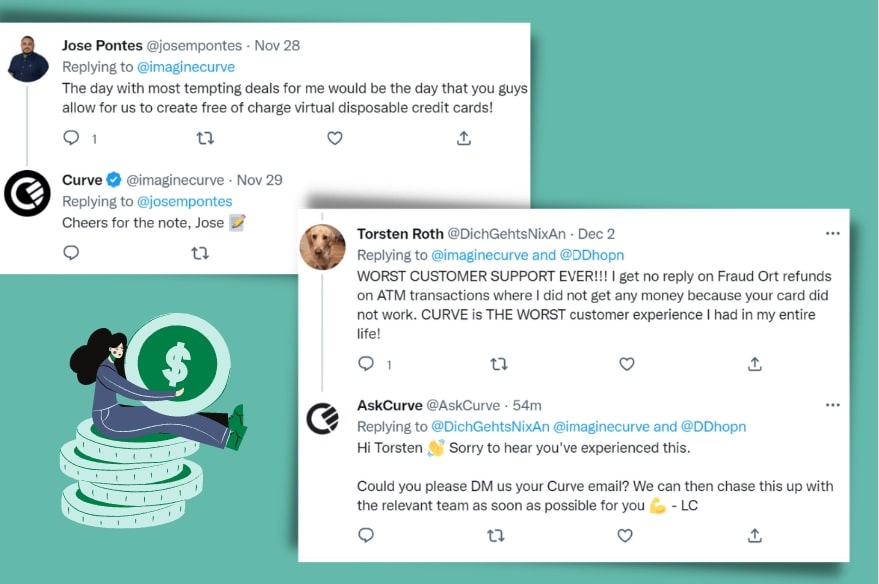
Especially after fintech is born, financial services are evolving rapidly every second with new cyber currencies and other digital developments like virtual credit cards. Banking has gone out of physical buildings, transactions are done online, and users are tech-savvy enough to make virtual investments, even via social media. And when it comes to money, users are exceptionally irritated by the low quality of customer service. Just like Curve, having a dedicated social media account for customer service (@askcurve) is crucial for this industry. Curve responds very quickly to engagement on its regular account (@imaginecurve) because, as a fintech company, it must build customer trust and loyalty and provide top-notch social media customer service, meaning that every engagement is worth responding to.
Since the volume of messages, comments and mentions are high in this industry, using an efficient tool to manage social media engagement is critical. Missing out on important customer queries can lead to an unexpected crisis, damaging online reputation.
Travel & Hospitality

While most businesses have a regular phone number or email address that customers can contact with questions or concerns, a niche market such as travel & hospitality businesses relies heavily on social media as the main customer communication method, even before the pandemic.
A business’s customer experience in the travel & hospitality industry can be easily and rapidly publicized with reviews, comments, and messages on social media. Word of mouth and customer reviews are the heart of this industry. When users post about their poor experiences with a travel & hospitality business, it can attract negative attention from other users as well, leading to an avalanche of posts and messages that need constant moderation. Providing personalized service and mastery to handle negative feedback can be the main focal points of the customer service strategy of a travel & hospitality business to make sure that the customer feels valued.
Further Reading

We have reviewed Airbnb’s social media customer service performance and rated its accessibility, response time, tone of voice, personalization, and engagement. Read the review now!
Tech & Software
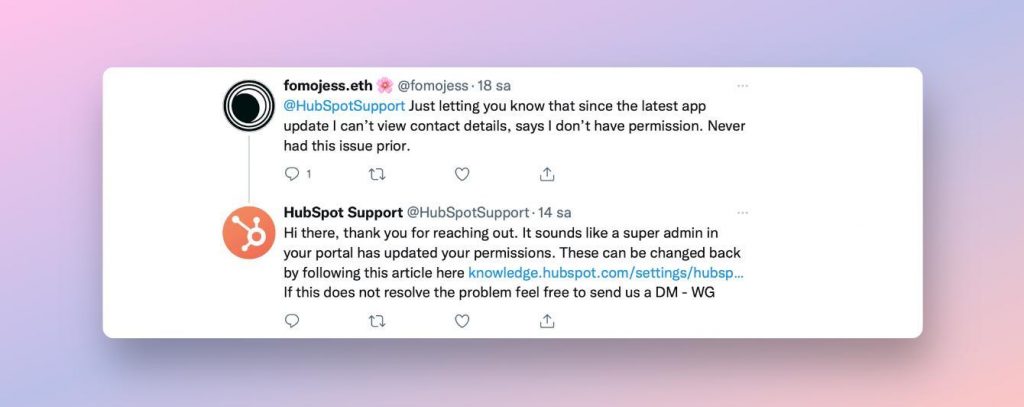
The most critical social media customer service element for the tech & software industry is ensuring customers receive support at all times possible. The SMCS team of a tech & software company does not have the luxury of disregarding or ignoring any user engagement on any platform. Users can have questions about various reasons at any stage of their customer journey since this industry is based on digital and complex products. Social monitoring is essential for this industry to avoid missing out on customer inquiries. Having a separate, customer service dedicated social media account is a good practice to build a trustful customer relationship from the start.

Intercom cares about communicating with customers on social media. However, customers will not tolerate unacceptable first response times like two days in this example.
Customer expectations of Intercom, as one of the customer service software leaders, will be higher than any other brand in this industry. Its SMCS team’s responsiveness and efficiency will always be tested.
Food & Beverage

The food & beverage industry, in general, has a high volume of social media posts related to customer service issues. This is because they are consumable products with many alternatives, so they should convince their audience. If they have poor social media management and if they are not active enough on social media, this can cause problems for businesses in the food and beverage industry, particularly those that rely on social media for their image and reputation. For example, most people have an Instagram “saved” category full of places and foods that they will explore ASAP! So, social media is a great platform for food & beverage companies in terms of marketing, image, and more.
Further Reading

We have reviewed Starbucks’ social media customer service performance and rated its accessibility, response time, tone of voice, personalization, and engagement. Read the review now!
Entertainment & Media

The entertainment & media industry was and will always be receiving the highest volumes of social media engagement since its products and services are based on the user’s artistic, personal, and subjective taste. Although this industry gets the highest engagement rates, most engagement does not have customer service value, resulting in low response rates. Nevertheless, they don’t require any assistance or response; all social media engagement should be moderated for the entertainment & media businesses because building a loyal and active social community is everything for this industry.
Further Reading

We have reviewed Netflix’s social media customer service performance and rated its accessibility, response time, tone of voice, personalization, and engagement. Read the review now!
Social Media Customer Service Statistics From Top Brands in 6 Industries
In this chapter, you will find the data charts for the average weekly inbound messages, response times, and response rates of six major industries on Facebook and Twitter. Surprisingly, a high volume of messages did not always end up with high response rates for some of the industries.
Average Weekly Inbound Messages
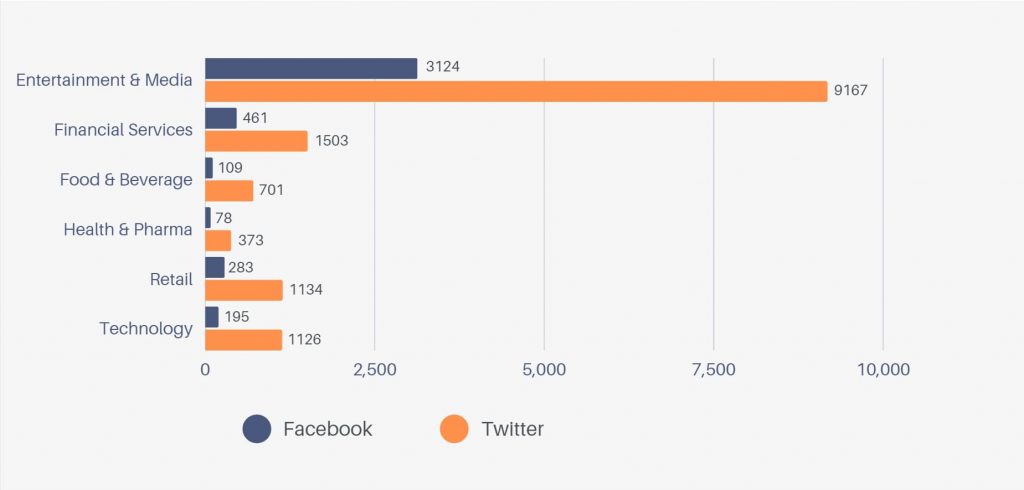
Its subjective nature enables the entertainment & media industry to have much higher volumes of social media engagement compared to other sectors; however, mostly, those messages don’t need support or response. On the other hand, health & pharma businesses receive the lowest number of direct messages since social media is still not the most convenient platform to be assured for health-related issues.
Facebook’s overwhelming loss against Twitter is nothing new, as Twitter has been the leading platform for social media customer service for the past several years. However, Sprinklr’s benchmark results gathered do not include the e-commerce industry, crushing Facebook and leaving Instagram out of the competition because Meta is an important marketplace for e-commerce businesses.
Average Weekly Replied Inbound Messages
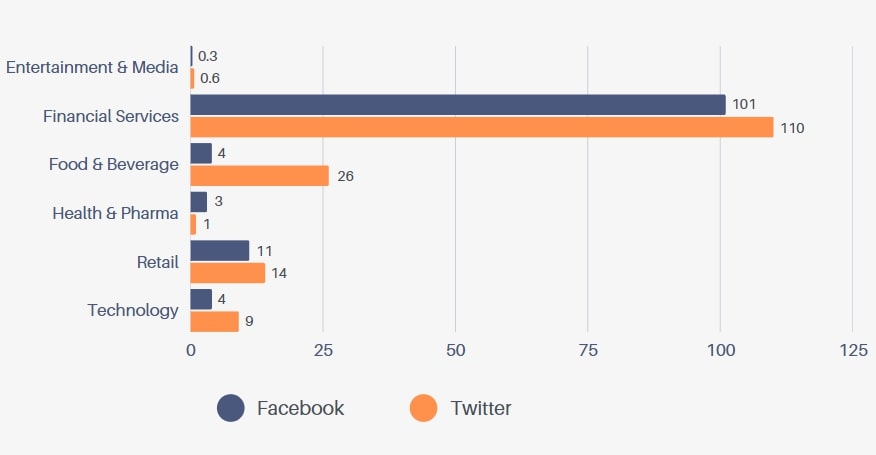
The chart above shows the average number of messages businesses reply to on social media by customer service teams in a week.
The customer service aspect in financial services’ inbound messages is very high that requires fast and helpful replies. Another unique data in the graph above is how financial services give the same amount of importance to Facebook messages as they give to Twitter DMs, indicating once again that economy-based businesses should not neglect any direct user messages, no matter which social media platform they are received.
Average First Response Times
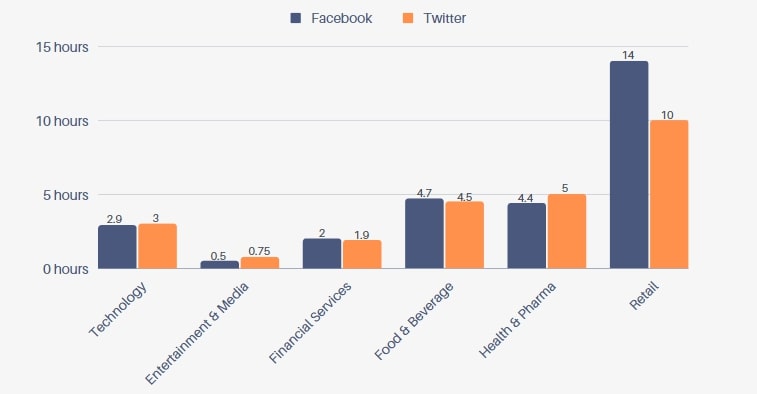
After the entertainment & media industry, the fastest response times come from financial services, followed by technology. The customer profile of the retail industry tolerates the longest response times, differentiating its customer base from e-commerce businesses.
Average Response Rates
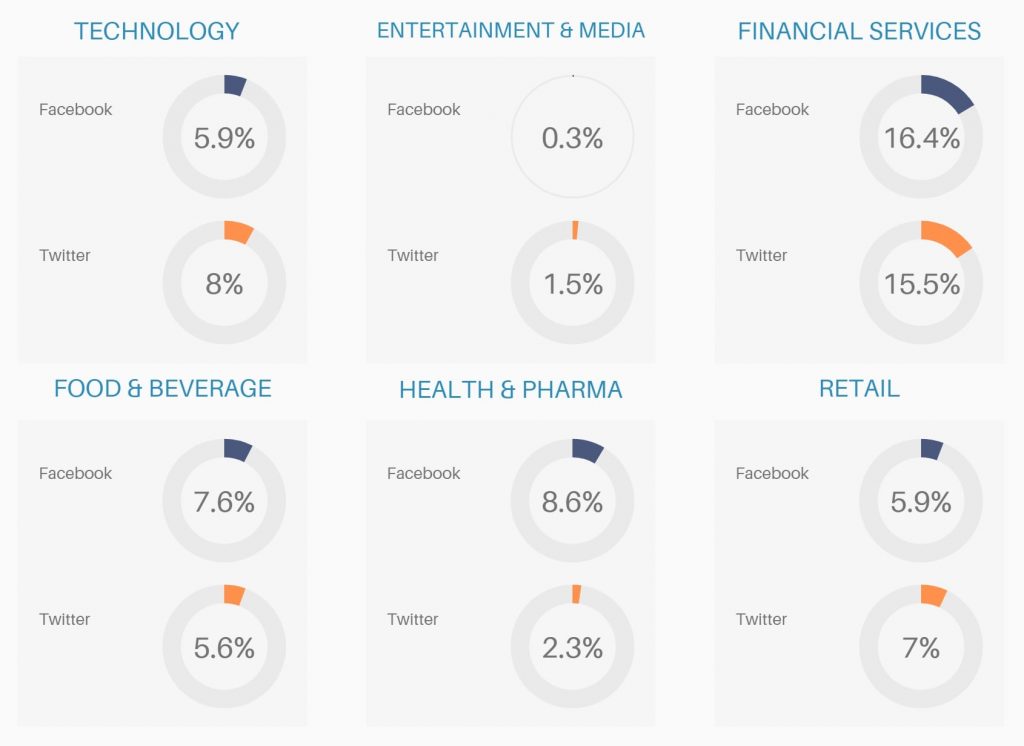
Health & pharma companies respond to messages on Facebook much more than on Twitter, whereas it is the opposite for technology brands. Financial services give Facebook and Twitter nearly equal care when responding to messages.
Social Media Customer Service Statistics From Juphy
We gathered Juphy’s platform authentication data and got the results in the chart below. The main reason why Twitter is the least authenticated platform is that majority of our customers are in the e-commerce industry, which heavily relies on Facebook and Instagram. Another key insight this chart gives is that Google My Business reviews are ahead of B2B powerhouse Linkedin, showing that B2B businesses don’t depend on social media customer service as much as B2C businesses.
Which Platforms Juphy Users Use the Most

Top 3 Platforms Juphy Users Use for Replying to Direct Messages
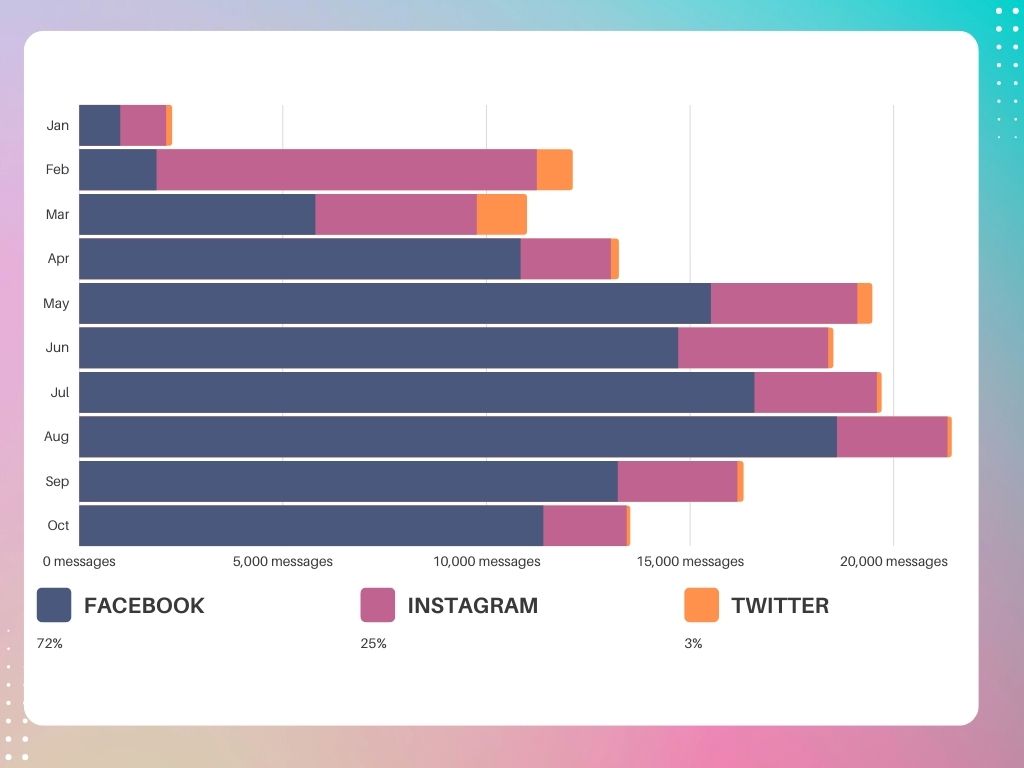
Replying to Facebook messages has been the most important SMCS component of Juphy’s customers this year, followed by Instagram and Twitter. According to this data, 72% of direct messages were replied to through Facebook, 25% were replied to through Instagram, and 3% were replied to via Twitter.
Juphy’s 12-Month Reply Comment Platform Distribution Rates
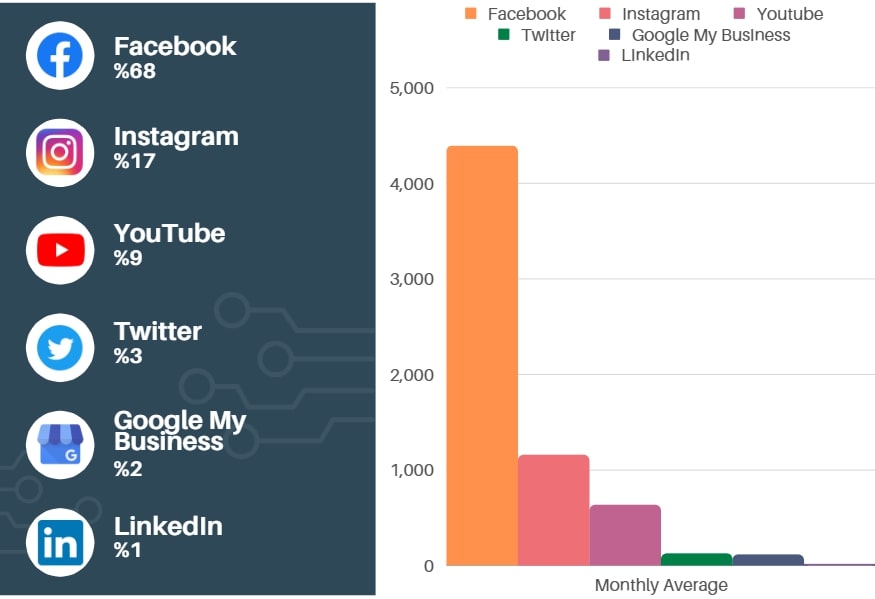
SMCS does not work by only managing direct messages. Comment management is just as crucial as replying to DMs for developing strong customer relationships. Building an engaging community for your brand also depends on effective comment management.
Most of Juphy’s customers are small to medium size businesses that make a great effort to grow their social media presence through content marketing in which video content is the king. That gives us YouTube becoming the third strongest platform for replying to comments.
Top 5 Resources for Social Media Customer Service
Social media customer service is an art that needs to be carefully studied, reviewed, practiced, implemented, and improved on. To do this, SMCS teams need tools and resources outside of SMCS software to expedite the training process.
Here are five useful resources teams can leverage for faster growth, brand consistency, and increased customer satisfaction.
1.Juphy Blog
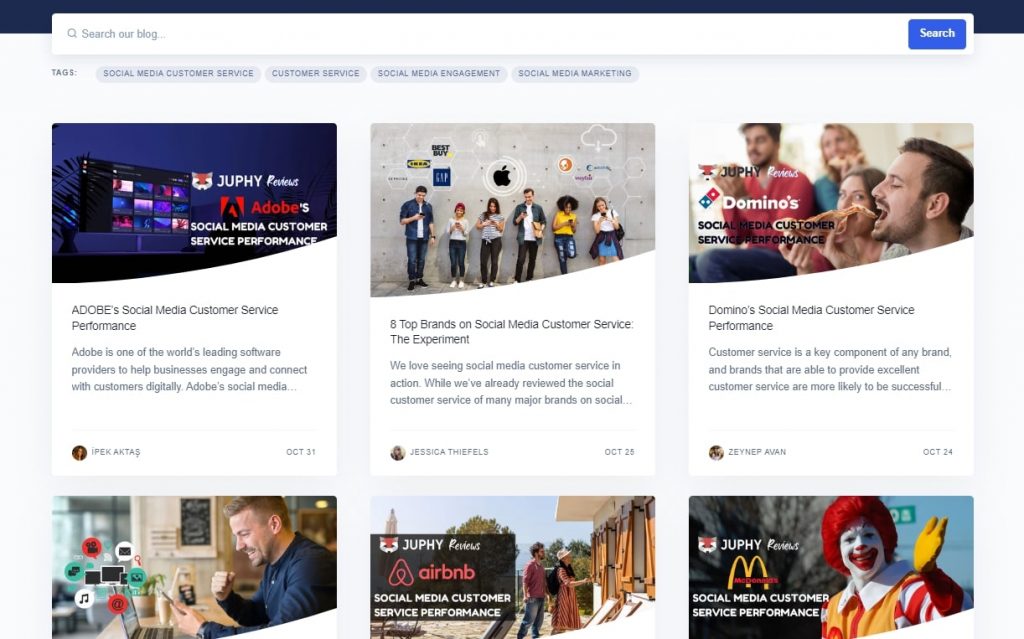
As a leading social media customer service tool, Juphy has a blog that is dedicated to providing businesses with top-notch content related to social customer service, social media engagement, social media marketing, and customer service in general.
Content on this blog is created by industry experts and exceptional social media content writers who understand the industry and how brands can maximize it for growth. The SMCS resources found on this blog include guides, experiments, reports, case studies, product recommendations, and many more.
A few well-loved SMCS resources on the blog include Juphy’s Social Media Customer Service: The Complete Guide E-book and the following blog posts:
Click here to visit the Juphy blog.
2. HootSuite’s Social Customer Service Toolkit

Although not entirely devoted to social customer care, HootSuite has a soft spot for SMCS that drives them to create great resources for SMCS teams. Among these resources are software tools and a toolkit containing blog posts, guides, and webinars to help teams drive customer satisfaction.
You can get access to the toolkit by filling out the form here.
3. HubSpot’s Social Media Customer Service 101: The Beginner’s Guide

4. Juphy’s Social Media Customer Service Glossary
Customer service teams that want to include social media customer care in their support strategy will find this glossary extremely useful. It contains an A-Z list of SMCS terms that social customer support teams often use in ticket resolution and other client interactions.
If you want to get familiar with the processes in SMCS quickly, this glossary will help you do that. Teams can also bookmark the glossary to have it handy when engaging with customers on social media. It’s the perfect tool for getting acquainted with SMCS lingo that you can use to improve collaboration with team members.
Get it here.
5. SEJ’s Social Media Customer Service Guide
There can never be too many guides when it comes to tackling social media customer care — especially because the social media industry is constantly evolving and your SMCS team has to keep up with customers’ needs.
Search Engine Journal (SEJ) put together an SMCS guide that’s been widely read and shared by teams around the globe. It answers FAQs about social customer support and helps you craft your SMCS strategy from scratch if necessary.
You can find the thorough guide here.

Tool Recommendation: Juphy
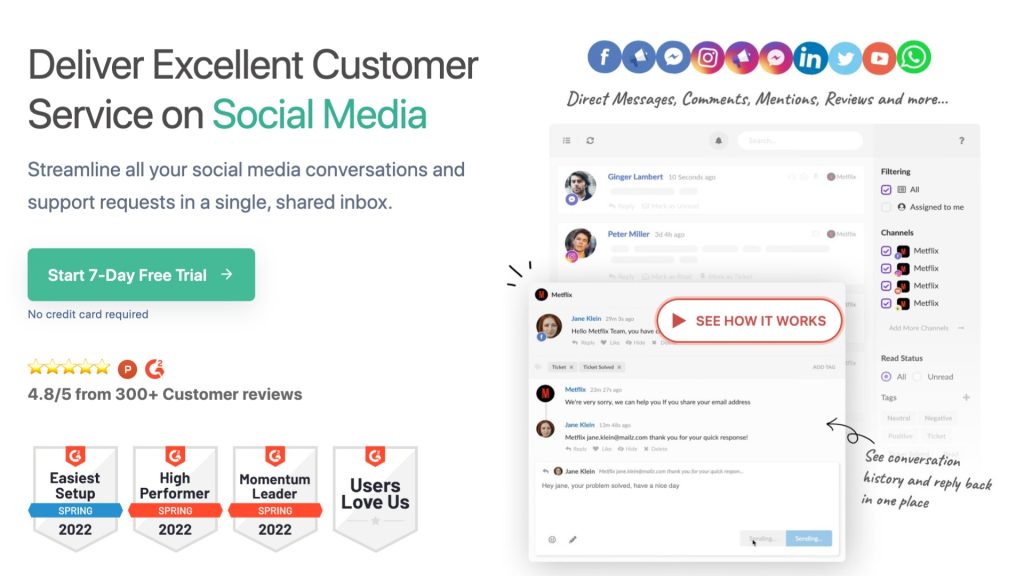
Juphy improves businesses’ social media customer service performance by enabling customer support teams to easily track all social conversations, including DMs, comments, and reviews, in a unified inbox.
Businesses that use Juphy can easily provide excellent customer service on social media by;
- Turning all social media conversations into customer support tickets that can be categorized and prioritized.
- Gather all support agents in a single dashboard and accelerate team productivity by collaborating on incoming social media messages.
- Improve social customer service performance with actionable reports based on engagement volume and team performance.
It’s a highly useful social media customer service tool for businesses managing numerous social media accounts, including Instagram, Facebook, Twitter, Whatsapp, and review platforms like Google My Business, App Store, and Google Play Store.
Its pricing structure is also affordable and flexible for both growing businesses and bigger teams. The best thing users love about Juphy is its time-saving, easy-to-use shared inbox for social media-focused teams. It’s a productivity enhancement tool that enables businesses to provide easier, faster, and smarter customer service on social media.
Skills and Requirements for SMCS Representatives
SMCS reps have a huge role to play in maintaining the brand’s reputation on social media and other online sites. Their adeptness in solving complaints and handling customer queries has a lot of impact on how customers view a brand.
Hence, if you’re looking to hire social media customer service representatives, knowing their roles and responsibilities will help you choose the best fit.
Most Important Skills SMCS Reps Should Have
Qualifications for SMCS vary across companies, but there are a few key skills that are common to all, including communication skills and technical skills.
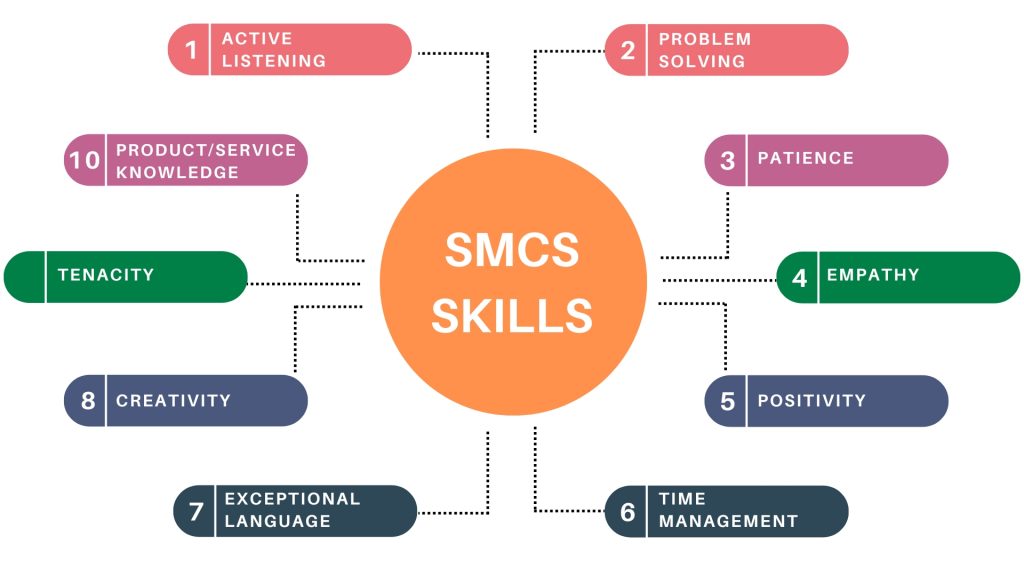
Active Listening and Clear Communication Skills: Listening and communication skills help agents deeply understand their customers, obtain information from them, and provide reasonable solutions to their problems. It’s more than listening to give a reply. They must be able to read and digest information to provide relevant responses.
Problem-solving Skills: Customers are not always able to self-diagnose their issues appropriately. Good problem-solving skills require SMCS agents to anticipate the challenge accurately and navigate the appropriate solution for the customer.
Patience and Attentiveness: SMCS reps will encounter different types of customers, including rude and impatient ones. A patient and attentive SMCS will try to remain unfazed in such situations and still proactively identify what customers are attempting to say without having to spell it out.
Emotional Intelligence: Good SMCS reps with high emotional intelligence will understand how to relate with any type of customer regardless of their personality.
Writing and Persuasion Skills:

Unlike one-on-one interactions, a good portion of SMCS issue resolution would be done in the form of writing and writing persuasively too. See how this job requirement by Wise describes it on the left. Good writing skills ensure your reps communicate in complete and grammatically correct sentences. Persuasive writing also helps convince customers who want to make a purchase that your product or service is the best fit for them.
Creativity and Positivity: Finding interesting and resourceful ways to solve your customers’ challenges can boost satisfaction scores. Agents that use positive language also help customers feel calm and at ease instead of focusing on the negative situation.
Time Management Skills: Speed and accuracy, as well as the ability to work within the confines of a time limit, are necessary requirements for SMCS agents. With many customers in the queue, the best SMCS professionals should be able to identify clients they can help quickly and those they need extra time with.
Tenacity: Some requests and complaints require agents to think outside the box and find solutions outside of the standard process to help customers. A good agent should be able to stick with the clients’ challenges until they find a reasonable solution.
Empathy: A good social customer service rep must be able to understand how customers feel in times of distress. Try to not just understand but also show care and concern for customers’ issues, helping them feel better while they look for a solution.
Product Knowledge: Knowledge of your business’s products and services is extremely essential for SMCS representatives. It enables them to accurately troubleshoot challenges your customers may be having with the product and know how to help. Many companies may need to provide training to help SMCS teams achieve this.
Technical Skills:
One key requirement for employing SMCS reps on the right job listing is a “strong knowledge of computer applications.” This is because SMCS requires representatives to work with various software and programs to provide adequate customer care and manage social media engagement. A good social customer service representative must have the required technical skills to navigate and operate this software without hassle. Company training may also be required to equip representatives with this skill.

Roles and Responsibilities of an SMCS Representative
Social media customer service representatives help to enhance and achieve a company’s social media marketing goals. We scouted the internet for the major roles and responsibilities companies expect their SMCS reps to carry out, and here are two recent job listings from Accenture and Wise:


The key SMCS representatives’ roles and responsibilities that align among these two listings include:
- Replying to customers’ queries and complaints via social media with great attention to detail
- Managing the brand’s social media engagement and visibility
- Social monitoring and listening for brand-related conversations on and around social media
- Reviewing social media posts to ensure accuracy in information and to remove inappropriate content and comments
- Keeping up with the latest trends on various social media platforms and using them to enhance brand visibility

- Gaining accurate and in-depth knowledge about company products and services to provide appropriate help to customers where necessary
- Maintaining brand tone and voice on all social media platforms to ensure brand consistency
- Work seamlessly with internal and external teams to ensure collaboration where necessary
- Leverage software and tools to provide industry-standard care to customers and prospects
Conclusion and 2023 Insights
From a total of 4.26 billion users in 2021, the number of people who use social media today currently stands at 4.59 billion. By 2027, this number is estimated to reach about 6 billion people, according to Statista’s reports.
One thing is quite clear; social media usage shows no indication of slowing down soon. Social customer support teams are currently overloaded with support tickets and requests, and many more users will still need support from SMCS teams well into the future.
Knowing that delays in social customer support create a bad look for the company online, how can teams surmount this rising challenge? What does the future of the SMCS industry look like?

By automating repetitive processes in social customer service operations, SMCS teams will be better able to save time and company resources. Chatbots and AI assistants can attend to specific customer queries and resolve complex tasks, freeing up time for SMCS reps to attend to other tasks that need a human touch.
AI assistants will be useful for collating and analyzing customer data, providing businesses with a clearer insight into their customers’ interactions on social media.
In addition, ensuring your social customer service teams receive the vital training required to handle the future demands of SMCS adequately is imperative. Since social media customer service is a combination of two distinct industries, the responsibility lies with business leaders to equip both ends for better social customer service. To achieve this, more social media customer service team members need to get a seat at the management table to get involved with the high-level strategy and planning that goes into the organization.
Social media leaders at the upper management should make moves to provide adequate training and certifications for the social media team to upgrade their customer service skills. On the other hand, leaders must ensure the customer service team also learns the critical skills necessary for handling current and future social media demands. The result is a better synergized SMCS team.
The social customer service industry continues to evolve, especially with the ongoing advancements in AI technology and machine learning. Adopting industry-standard SMCS tools, as well as the latest updates in the industry, is the best step for SMCS leaders. It equips your team to consistently provide customers with improved social customer service for now and for the future.
We hope our Social Media Customer Service Report can help you optimize your customer service, social media, and marketing strategies.